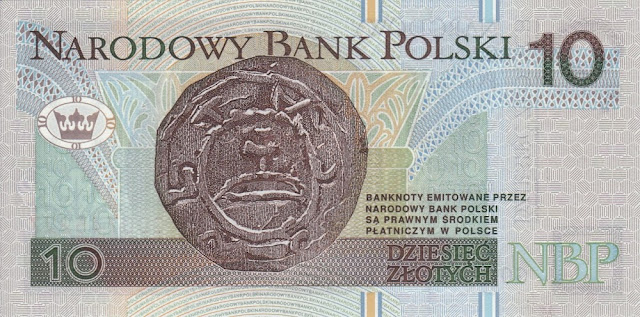Polish banknotes 10 Zlotych note 1994, issued by the NBP
National Bank of Poland - Narodowy Bank Polski
Polish złoty, Polish banknotes, Poland banknotes, Polish bank notes, Polish paper money, Poland bank notes, Poland paper money.Front design: Portrait of Prince Mieszko I in centre area, with inscription, "MIESZKO I", in decorative medallion. Left of portrait - at top, inscription, "NARODOWY BANK POLSKI"; below that - depiction of eagle, emblem of Polish Republic; below that - inscription, "WARSZAWA 25 MARCA 1994 r."; below that - inscription, "PREZES", and signature; below that - inscription, "GLOWNY SKARBNIK", and signature. In background of inscriptions and emblem - two stylised Romanesque rosettes. On left-hand side of note, in area of watermark - composition of guilloche lines. In top left-hand corner, arranged vertically - number "10", with line underneath and inscription below, "DZIESIEC ZLOTYCH". In bottom left-hand corner - marking for the visually impaired, consisting of square with raised edges. Right-hand side of note contains two separate fields, upper and lower. Upper field bears number "10", with drawing of crown in oval below and four "10"s around crown, and decorative floral ornamentation underneath. Numerical denomination of note in top left-hand corner, line below that, marking for the visually impaired and lower right-hand field are all filled with white ornamentation. Background of front of note consists of guilloche mesh with intersecting lines of light green, blue, grey-blue and yellow.
Back design: Depiction of denar, silver coin from reign of Mieszko I, in centre area. On both sides of denar - fragments of Romanesque columns. At top - inscription, "NARODOWY BANK POLSKI". Below denar - rectangular field of ornamentation bearing number "10" to left and inscription, "DZIESIEC ZLOTYCH", to right. To left of denar, against background of guilloche ribbon - crown in oval, with four "10"s around crown. To right of denar - legend, "BANKNOTY EMITOWANE PRZEZ NARODOWY BANK POLSKI SA PRAWNYM SRODKIEM PLATNICZYM W POLSCE". Below drawing of crown and in background of legend - composition of guilloche lines making up repeated number "10". On right-hand side of note, at top, against background of guilloche ribbon - number "10" filled with white ornamentation. In bottom right-hand corner - initials "NBP". In area of watermark - composition of guilloche lines.
Watermark: Portrait of Prince Mieszko I
Polish złoty banknotes, "Sovereigns of Poland", (1994)
In 1995, notes were introduced in denominations of 10 złoty, 20 złoty, 50 złoty, 100 złoty and 200 złotych.
Mieszko I (940 – 25 May 992), was the ruler of the Polans from about 960 until his death. A member of the Piast dynasty, he was son of Siemomysł; grandchild of Lestek; father of Bolesław I the Brave, the first crowned King of Poland; likely father of Świętosława (Sigrid), a Nordic Queen; and grandfather of her son, Cnut the Great.
The first historical ruler of Poland, Mieszko I is considered the de facto creator of the Polish state. He continued the policy of both his father and grandfather, who were rulers of the pagan tribes located in the area of present Greater Poland. Either through alliances or by use of military force, Mieszko extended the ongoing conquests and early in his reign subordinated Kuyavia and probably Gdańsk Pomerania and Masovia. For most of his reign, Mieszko I was involved in warfare for the control of Western Pomerania, eventually conquering it up to the vicinity of the lower Oder. During the last years of his life he fought the Bohemian state, winning Silesia and probably Lesser Poland.
Mieszko I's marriage in 965 to the Czech Přemyslid princess Dobrawa and his baptism in 966 put him and his country in the cultural sphere of Western Christianity. Apart from the great conquests accomplished during his reign (which proved to be fundamental for the future of Poland), Mieszko I was renowned for his internal reforms, aimed at expanding and improving the so-called war monarchy system.
According to existing sources, Mieszko I was a wise politician, a talented military leader and charismatic ruler. He successfully used diplomacy, concluding an alliance with Bohemia first, and then with Sweden and the Holy Roman Empire. In foreign policy, he placed the interests of his country foremost, even entering into agreements with former enemies. On his death, he left to his sons a country of greatly expanded territory, with a well-established position in Europe.
Mieszko I also enigmatically appeared as "Dagome" in a papal document dating to about 1085, called Dagome iudex, which mentions a gift or dedication of Mieszko's land to the Pope (the act took place almost a hundred years earlier).

